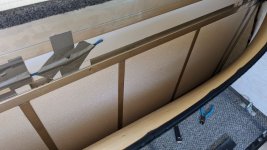ramblinChet
Well-known member
Does anyone know the thickness and dimensions of the aluminum tubing in the Four Wheel Camper?
My plan is to mount a Maxtrax carrier which includes four Maxtrax on the drivers side up near the front. I was thinking of using four or maybe even six bolts to pass through the carrier, outer wall, frame, inner wall, and maybe use an some aluminum plate for reinforcement on the inside. I am concerned with crushing the tube though since I don't know how thick it is. From what I gathered so far it is 1"x1" aluminum square stock - I am just not sure how thick though.
As you can see I have much room on the drivers side up towards the front to mount:


My plan is to mount a Maxtrax carrier which includes four Maxtrax on the drivers side up near the front. I was thinking of using four or maybe even six bolts to pass through the carrier, outer wall, frame, inner wall, and maybe use an some aluminum plate for reinforcement on the inside. I am concerned with crushing the tube though since I don't know how thick it is. From what I gathered so far it is 1"x1" aluminum square stock - I am just not sure how thick though.
As you can see I have much room on the drivers side up towards the front to mount:



